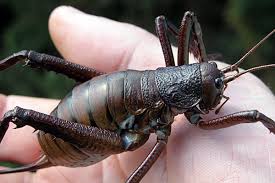Otumoetai Rotary has some bugs in it.
 THE PRESIDENT’S MINUTE
THE PRESIDENT’S MINUTEOur Vision To grow as a vibrant and professional group of diverse, supportive members who make a positive difference by supporting the community.
Mahoenui Giant Weta (Deinacrida mahoenui) In 1962 a population of giant weta were discovered in remnant populations of tawa forest at Mahoenui in the southern King Country. It was assumed that the weta only occurred in these remnant (1 to 5 hectare) forest patches until further study in 1987 revealed greater numbers of weta on farmland reverting to gorse.
By August 1990 about 240 hectares of gorse habitat was purchased by the Department of Conservation as a reserve for the weta. The unlikely combination of cattle, goats and gorse bushes has set up a unique habitat for the weta. Cattle have established trails and tunnels in the undergrowth by pushing through the gorse bushes. The trails allow more light in which promotes fresh green growth, and also allows access for wild goats to browse on gorse and other plants in the area. Browsing by the goats crops the gorse bushes into dense “hedges”, and these spiny fortresses provide sanctuary from introduced predators for the weta. Mahoenui Giant Weta are unique amongst the giant weta species in having two different colour morphs. Although most of the Mahoenui weta (69%) tend to be a dark brown mahogany colour, 31% are a lovely yellow, and one female was even discovered with mahogany for half of her body and the other side to be yellow.
Females are larger than males, with adults measuring up to 75mm and 50mm respectively. Females have been weighed at up to 19 grammes and males up to 12g. The total life cycle (22 – 24 months) of Mahoenui Giant Weta is short compared to some tree weta which live for up to 12 years in captivity. Eggs are laid in the soil in autumn and incubation takes about 10 months. The first nymphs start emerging around March or April of each year. In the first 4 months after hatching the young weta literally “grow out of their skin” every month. Their exoskeleton is shed every month until August, then every 2 months until February. Mahoenui Giant Weta shed their skin, or moult, ten times throughout their life and each stage is called an instar.
Once the weta reach maturity in autumn each year the females emit pheromones in their droppings. Males follow the scent until finding a female.. If she is ready she will stay still and they will mate. Once the females lay eggs, all the adults will die before winter.
Adult females are very susceptible to predation from hedgehogs, possums, rats, cats and stoats when they come down to the ground to lay eggs. Females have a long ovipositor which looks like a spike at the end of their body. They use the ovipositor to lay between 200 and 400 eggs up to 23 mm below the surface of the soil. Each egg is a little vertical cylinder about 7mm long, and when the young nymphs’ first hatch out they are only 8mm long.
Young nymphs are cannibalistic and like to eat other insects including caterpillars, spiders, cicada and crickets while they are growing rapidly. They also eat leaves, bark and dead leaf litter. Because of their cannibalistic diet, Mahoenui Giant Weta are generally solitary insects. If an intruder enters their territory they make warning sounds by extending their abdomen in and out to create clicks or by striking their hind legs against their abdomen to create a rasping sound. They will attempt to push or scare off predators by quickly raising their spiny hind legs.
Because of the danger that a fire could wipe out the entire Mahoenui Giant Weta Scientific Reserve, a number of weta have been translocated to other areas. 287 Mahoenui Giant Weta have been released at Warrenheip near Cambridge, 200 have been released on Mahurangi Island and a number have been released at Ruakuri Scenic Reserve at Waitomo Caves. For the last 190 million years this insect has remained essentially unchanged on planet Earth. Hopefully, with continual work, research and education we will help to keep this insect around for a bit longer.
Females are larger than males, with adults measuring up to 75mm and 50mm respectively. Females have been weighed at up to 19 grammes and males up to 12g. The total life cycle (22 – 24 months) of Mahoenui Giant Weta is short compared to some tree weta which live for up to 12 years in captivity. Eggs are laid in the soil in autumn and incubation takes about 10 months. The first nymphs start emerging around March or April of each year. In the first 4 months after hatching the young weta literally “grow out of their skin” every month. Their exoskeleton is shed every month until August, then every 2 months until February. Mahoenui Giant Weta shed their skin, or moult, ten times throughout their life and each stage is called an instar.
Once the weta reach maturity in autumn each year the females emit pheromones in their droppings. Males follow the scent until finding a female.. If she is ready she will stay still and they will mate. Once the females lay eggs, all the adults will die before winter.
Adult females are very susceptible to predation from hedgehogs, possums, rats, cats and stoats when they come down to the ground to lay eggs. Females have a long ovipositor which looks like a spike at the end of their body. They use the ovipositor to lay between 200 and 400 eggs up to 23 mm below the surface of the soil. Each egg is a little vertical cylinder about 7mm long, and when the young nymphs’ first hatch out they are only 8mm long.
Young nymphs are cannibalistic and like to eat other insects including caterpillars, spiders, cicada and crickets while they are growing rapidly. They also eat leaves, bark and dead leaf litter. Because of their cannibalistic diet, Mahoenui Giant Weta are generally solitary insects. If an intruder enters their territory they make warning sounds by extending their abdomen in and out to create clicks or by striking their hind legs against their abdomen to create a rasping sound. They will attempt to push or scare off predators by quickly raising their spiny hind legs.
Because of the danger that a fire could wipe out the entire Mahoenui Giant Weta Scientific Reserve, a number of weta have been translocated to other areas. 287 Mahoenui Giant Weta have been released at Warrenheip near Cambridge, 200 have been released on Mahurangi Island and a number have been released at Ruakuri Scenic Reserve at Waitomo Caves. For the last 190 million years this insect has remained essentially unchanged on planet Earth. Hopefully, with continual work, research and education we will help to keep this insect around for a bit longer.
